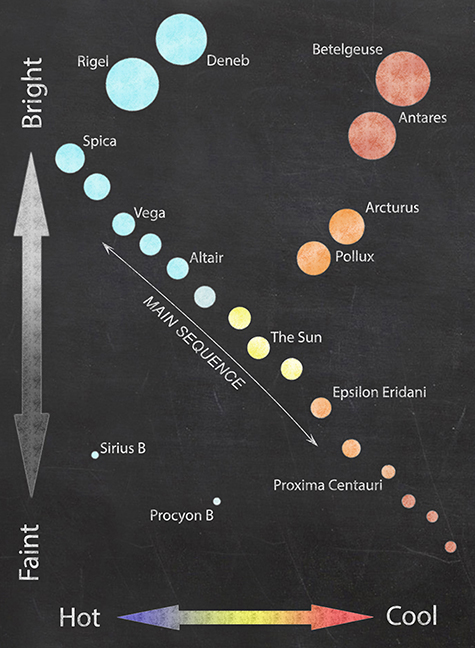2.2 The life of a star
Once a star has formed, it has a lifecycle which is fairly predictable, and which depends on how massive the star is at its birth.
It is possible to determine how a star will evolve by working out where it sits on a Hertzsprung-Russell (HR) diagram below. The diagram plots stellar luminosity against temperature, and was first constructed by the Danish astronomer Ejnar Hertzsprung in 1906 and then, independently, by the American Henry Norris Russell, using a more extensive set of data, in 1913. Note that temperature, which is plotted on the horizontal axis, decreases from left to right.
The HR diagram shows that stars have only certain combinations of temperature and luminosity. The clearest feature to notice is that most stars occupy a thin strip in the diagram from top left (very luminous stars of high temperature) to bottom right (very faint, cool stars). In colour terms, the most luminous stars known are bright blue, becoming redder as they become fainter. The Sun is on this strip too, as are 90% of stars. Since this is where stars spend the vast majority of their lives, it is known as the main sequence.
The position of a star on the main sequence depends solely on its mass: the more massive a star is, the hotter and more luminous it is. The main sequence cannot be an evolutionary sequence because the stars along it have very different masses and will change in different ways as they age and move away from the main sequence.
Stars on the main sequence are sub-classified with letters, O-B-A-F-G-K-M. O-type stars are the hottest, largest and brightest stars, and M-type stars are the smallest, dimmest and coolest (red dwarfs). The Sun is a G-type star. Because the main sequence is not an evolutionary sequence O-type stars do not become B-type then A-type as they age.
In fact, when stars evolve, they move off the main sequence to different parts of the HR diagram. The blue giant stars (hot and bright), red giant stars (cool and bright) and white dwarf stars (hot and faint) shown on the diagram above represent some of these stages of evolution, which you'll read about in later sections.
You can see that high mass, hot stars on the main sequence have high luminosity, whilst low mass, cool stars on the main sequence have low luminosity. This indicates that high mass stars use up their fuel quickly and so have relatively short lives, while low mass stars use up their fuel slowly and so have longer lives.
Look at this image showing different endings for different types of star [Tip: hold Ctrl and click a link to open it in a new tab. (Hide tip)] , depending on their original mass. In the image, mass is increasing from the bottom upwards. The biggest stars (those with masses at least eight times the mass of the Sun) become supernovae, while the smaller ones just gradually burn away.
In the next section, you will look at different types of star.

